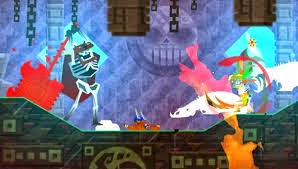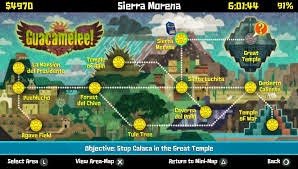Springtime in New England is the time of year when the snow melts, the birds return, the trees sprout leaves, and major videogame developers from around the globe gather in Boston for the annual PAX East convention. There are always big game announcements at the show, but I tend to get excited for the more unexpected titles. This past year was probably a toss up between Octodad and Throw Trucks With Your Mind. In 2012, it was DuckTales Remastered that really took me by surprise. But in 2011, the biggest smile on my face happened while learning about Guacamelee!
There have been a few different versions released of Guacamelee! for different systems including Gold Edition and Super Turbo Championship Edition, but for this review I'll stick to the core game that's common to all of the releases. Personally, I played the Gold Edition on PC, but whether you're on a Vita, a Wii U, or a Surface Pro, the basics of the game are still the same.
So, what is Guacamelee!? In my Ittle Dew review I talked about clones, as it was an obvious tribute to the Legend of Zelda series. Guacamelee! takes a similar approach, but uses the Metroid series as its source of inspiration instead. Metroid clones, or Metroidvanias, have become common enough to be a declared a legitimate genre of their own, and Guacamelee! proudly plants its flag directly in the center of this genre.
Remember those Chozo statues from the Metroid games? Here they're Choozo statues. What about the iconic Morph Ball or Maru-Mari? How about just turning into a chicken instead? Energy containers? Heart containers. Wait, heart containers? That's not Metroid, that's Zelda! Yes, while it's primarily based around a Metroid core, Guacamelee! pulls influence from other iconic games as well. One of my favorite moments was after a Super Meat Boy worthy chase scene, you reach a giant axe which destroys a bridge, dropping your pursuer into a pit of fiery lava in tribute to the original Super Mario Bros. Of coarse, this is followed promptly by a "Your princess is in another castle" quote.
This type of influence awareness and blatant referencing is a large part of the game's humor. Even in the background there are constant subtle references to various videogames, pop culture icons, and so many memes. What's unique about Guacamelee! though is that while so obviously tongue in cheek and full of jokes, the story is presented completely seriously with real emotion, or as real as you can get from typed dialog cut-scenes. Unlike Ittle Dew, there's no breaking the fourth wall, no winking at the audience, and no breaking character. The final moments of the game's conclusion in particular are especially touching.
The story of Guacamelee! follows a Mexican agave farmer turned undead luchador as he quests to rescue El Presedente's daughter from the reanimated skeleton of one of Mexico's baddest banditos. The adventure carries you across the country both through the land of the living and the land of the dead. As with Giana Sisters: Twisted Dreams, there's a lot of carefully timed jumping back and forth between worlds.
But, what's it like to actually play Guacamelee!? While the Metroid series is all about blasting aliens with an assortment of lasers and ray guns, Guacamelee! has no guns. As the name implies, it's all about melee combat. Being a luchador, you'll be punching, kicking, and otherwise beating the snot out of all of the undead agents of evil you encounter. Additional moves are learned along the way that in addition to providing new ways to beat up the baddies, allow you to access new areas as you advance through the game.
These new moves not only increase your mobility, they also allow you to break through various obstacles. The obstacles themselves are color coded to indicate which of the special moves is required to destroy them. This is important to note because later in the game there are enemies protected by colored shields which can only be broken by the appropriate special move as well. This is reminiscent of the color coded armor worn by the space pirates in Metroid Prime which revealed which of Samus' weapons would be effective. There are also enemies that can only be hurt while your luchador is in the correct world, living or dead. As you can imagine, a screen full of various color coded enemies spread between the two worlds takes a great deal more strategy to contend with than your average beat 'em up.
Visually, Guacamelee! has a rather unique style. It reminded me mostly of the Samurai Jack animated series. It's not flat, not realistic, not really a traditional cartoony style either despite being highly stylized with exaggerated proportions. It's a look that fits well with the subject matter however. Add in some flamenco guitar and mariachi serenading and the audio track compliments the visuals just as nicely.
As would be expected, the world of Guacamelee! is quite expansive with a number of large interconnected areas. Being a Metroidvania, you'll also have plenty of backtracking to contend with as you try to figure out where to go next and how to get there. Gamers either love this or hate it, so keep this in mind as you decide whether or not this is a title you feel like sinking your time into. Luckily there is a useful fast travel system which manages to speed up the process without nerfing the experience.
As a huge fan of Metroidvanias with a soft spot for beat 'em ups, this game felt like it was designed specifically for me. If you have similar tastes, you'll probably love this well polished game. If backtracking and exploration aren't generally your thing, but you're all about delivering flying uppercuts while double jumping across bottomless chasms, you might still get a kick out of Guacamelee! It might not be for everybody, but this is a game that will make a lot of people happy.












No comments:
Post a Comment